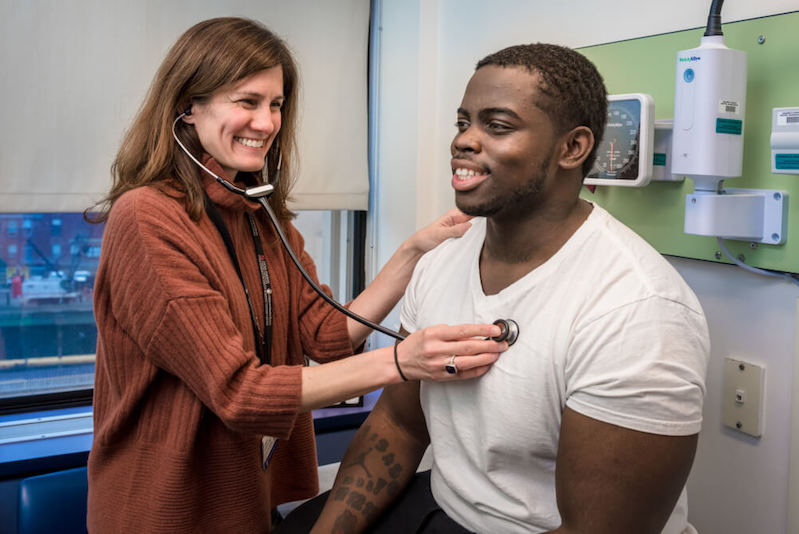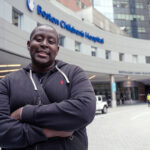Manny: Hoping new research helps others with sickle cell disease

Emmanuel “Manny” Johnson, Jr., shares many loves with his little brother, Aiden — from basketball to video games. One thing he wishes they did not share is sickle cell disease (SCD), so Manny is playing a role in a new effort to improve treatment for patients like 7-year-old Aiden, himself and others living with the inherited blood disorder.
Johnson, 21, is the first patient to participate in a clinical trial currently underway at Dana-Farber/Boston Children’s Cancer and Blood Disorders Center that is testing a novel gene therapy approach for treating SCD. After needing monthly blood transfusions for 17 years to control his disease, Johnson has been symptom-free for six months. The Dana-Farber/Boston Children’s team running the clinical trial, led by co-principal investigator Dr. Erica Esrick, now plans to treat additional patients between ages 3 and 40 in the ongoing study.
“I am doing this so that my brother might not need all the years of treatment I’ve had to go through,” says Johnson, who completed the trial in May. “When I found out he was born with the same thing as me, it was all the motivation I needed to be part of anything I could to potentially stop it.”
Sickle cell basics
Red blood cells containing normal hemoglobin are smooth, flexible “O”-shaped discs that move easily through blood vessels carrying oxygen. In SCD, a mutation in the hemoglobin molecule distorts red blood cells, making them stiff and creating a crescent or sickle shape from which the disease gets its name. These stiff red blood cells can block blood vessels, preventing adequate delivery of oxygen to organs and tissues. Symptoms of SCD can include anemia, repeated pain episodes that often require hospitalization, and life-threatening organ damage.
Clinical trial focuses on newborn hemoglobin
Newborns have a different hemoglobin called fetal hemoglobin that doesn’t sickle. The goal of this clinical trial is to flip the switch in SCD red cells back to fetal hemoglobin, which should prevent sickling from occurring.
The clinical trial is the result of collaborative research all done at Dana-Farber/Boston Children’s. Key basic research leading up to the trial includes the 2008 discovery by Dr. Vijay Sankaran and Dr. Stuart Orkin that variations in the expression of a gene known as BCL11A can affect levels of fetal hemoglobin. Using this knowledge, an investigative research team led by Dr. David A. Williams spent several years devising how to thwart BCL11A production.
The trial requires patients to undergo a hospitalization and chemotherapy to prepare them for a process similar to a stem cell transplant. Their blood stem cells are removed, and then undergo months of gene modification to reduce BCL11A expression and induce production of healthy fetal hemoglobin. The gene-modified cells are then given back to the patient by an intravenous infusion. The patients require one-to-two months as an inpatient in the hemopoietic stem cell transplant unit at Boston Children’s Hospital.
‘Seizing the opportunity’ to help Aiden, others
“When Manny received the infusion of his own stem cells back in May, it was an emotional day for the whole team,” says Esrick. “This is an exciting time for patients, physicians, and researchers in the sickle cell disease community, with potentially curative approaches such as gene therapy and gene editing.”
After several months of recovery, Johnson is now back to playing sports and is looking into college. He’s also spending more time with Aiden, also a patient at Boston Children’s for his SCD. When Johnson got a tattoo with a sickle cell ribbon and Aiden’s name in it, his little brother thought it was cool.
“I wanted to seize the opportunity offered me to participate in this trial, and I’m glad I did,” Johnson says. “It would mean a lot to me and obviously a lot of other people — including Aiden — if it worked out.”
Learn more about the Sickle Cell Disease Treatment Program.
Related Posts :
-

The journey to a treatment for hereditary spastic paraplegia
In 2016, Darius Ebrahimi-Fakhari, MD, PhD, then a neurology fellow at Boston Children’s Hospital, met two little girls with spasticity ...
-

The dopamine reset: Restoring what’s missing in AADC deficiency
In March 2023, a young girl came to Boston Children’s Hospital unable to hold up her head — one striking symptom ...
-

Could a pill treat sickle cell disease?
The new gene therapies for sickle cell disease — including the gene-editing treatment Casgevy, based on research at Boston Children’s ...
-

A sickle cell first: Base editing, a new form of gene therapy, leaves Branden feeling ‘more than fine’
Though he doesn’t remember it, Branden Baptiste had his first sickle cell crisis at age 2. Through elementary school, he ...





